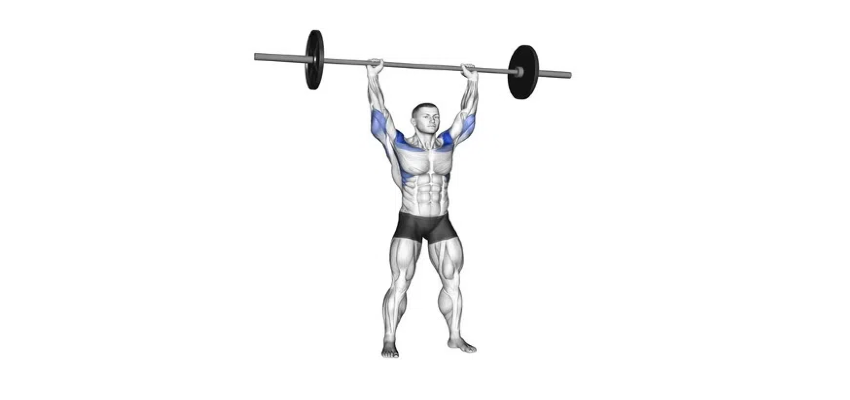Strict press strength standards didn’t matter to me at first. I was just pressing weight overhead and hoping it meant I was strong. No plan, no clue—just vibes.
But eventually, I hit a wall. My overhead press stopped moving. I’d add five pounds, fail. Try again next week, fail harder. So I started wondering… what’s actually considered “good” when it comes to strict press?
That’s when I fell into the Reddit black hole. Strength charts, spreadsheets, dudes bragging about 1RMs with questionable form. Some said bodyweight was elite. Others said it was just decent. It was all over the place.
So I made it a mission. I wanted to figure out what these numbers really meant—for real people, not just elite lifters or dudes with perfect leverages.
And I’ll be honest: a lot of those so-called standards? Kinda misleading.
What Are the Strict Press Strength Standards?
Once I realized I needed a goal, I started digging into strict press strength standards. I didn’t want a vague “get stronger”—I wanted numbers. Real ones.
Here’s a rough guide I put together based on bodyweight and training level. Nothing fancy, but it’ll give you a solid target:
| Strength Level | Men | Women | ||
|---|---|---|---|---|
| Weight | Bodyweight Ratio | Weight | Bodyweight Ratio | |
| Beginner | 69 lb | 0.40x | 31 lb | 0.20x |
| Novice | 101 lb | 0.55x | 50 lb | 0.35x |
| Intermediate | 142 lb | 0.80x | 76 lb | 0.55x |
| Advanced | 189 lb | 1.05x | 106 lb | 0.75x |
| Elite | 241 lb | 1.35x | 140 lb | 1.00x |
A few quick things:
- This is based on a one-rep max, not repping out.
- It’s a general chart, not some official rulebook.
- If you’re pressing 145 lbs for 9 reps like that Reddit guy? That’s already really solid.
For me, hitting 65–70% of my bodyweight felt like a turning point. Once I crossed that line, everything started feeling more locked in.
Don’t trip if you’re not hitting those numbers yet—it’s a guide, not some leaderboard you gotta win.
What Actually Affects Your Strict Press Strength
Once I started chasing strict press strength standards, I realized something: those charts don’t tell the full story. There’s a lot more going on under the hood. If you’re comparing yourself to a random number online, this part’s for you.
Why Some Strength Standards Are Misleading
I used to look at “elite” numbers online and think, “Damn, I’m weak.” But here’s the truth:
- Most charts assume perfect leverages and no injuries
- They don’t care if you’re tall, lanky, or new to lifting
- And yeah, some are based on competitive lifters, not regular gym folks
The numbers aren’t useless—they just don’t tell your whole story. Real-world strong is different from “on-paper” strong.
How Your Anatomy Changes the Game
Not everyone presses the same. I’ve seen guys with short arms and wide torsos fly through overhead lifts, while tall dudes like me struggle.
Here’s what really matters:
- Arm length = longer range = harder press
- Shoulder mobility can make or break your setup
- Taller lifters usually have a tougher time locking it out
- Big upper backs and thick frames? Big help
So yeah, blame your bones a little. Just don’t let them be an excuse.
How Age Affects Overhead Strength
Let’s be real—your age plays a part too. I’m in my 20s, so I’m in that sweet spot for gains. But I’ve seen people in their 40s and 50s press just as strong.
- Strength peaks around your 20s–30s
- But smart training means you can still build power in your 40s, 50s, even 60s
- Your progress might slow, but it won’t stop—unless you quit
So don’t compare your press to a TikTok lifter in college. Run your own race.
How I Set Realistic Strict Press Goals
Here’s what helped me stop spinning my wheels and actually get stronger:
Step 1: Benchmark Your Max
Figure out your current 1-rep max (or calculate it from a rep set). That’s your starting line.
Step 2: Pick a Target Tier
Decide if you want to hit “intermediate,” “advanced,” or whatever. Don’t try to PR everything in one shot—you’ll gas out fast.
Step 3: Build a Plan That Makes Sense
Mix in different barbell strict press variations. Push press for power, Z press for core, landmine press on light days. I trained the press 1–2 times a week and kept it simple.
Want to Get Stronger? Do This Instead
These were the biggest changes that made my press move:
- I stopped ego lifting. No more ugly grinders just to feel tough.
- I trained consistently, even on bad days.
- I used volume work and added accessories—Z presses, band presses, core stuff.
- I actually rested between sets. Sounds obvious, but I used to rush.
- And yeah, I pressed every week. No skipping.
Progress was slow. But it was real.
Whether you press 65 lbs or 200 lbs, it’s your barbell to chase. Don’t let dudes with fake numbers throw you off track.

Hi, I’m the editor here at Leadman Fitness. We’re a manufacturer focused on producing top-quality barbells, plates, kettlebells, dumbbells, and strength training gear. I’ve been into sports and fitness for years, and I know my way around all kinds of gym equipment—both from using it and helping create it.
I spend a lot of time understanding the real problems people run into in the gym—whether it’s beginners trying to pick the right gear or experienced lifters looking for something more durable. I stay in close touch with our production team and talk directly with other equipment makers, so we’re always improving based on what real lifters and coaches are looking for.
What I share comes from hands-on experience—stuff that actually helps people train better, not just in theory, but in real gyms.
